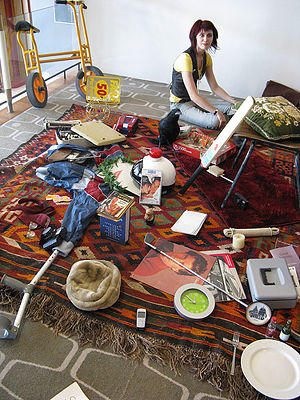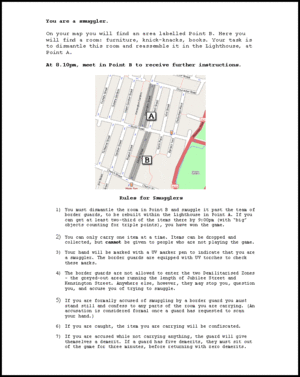Checkpoint
| Checkpoint | |
|---|---|

| |
| Designer: | Andy Field |
| Year: | 2008 |
| Players: | 10-40 |
| Stuff required: | A big pile of furniture and junk to smuggle. Hats or costumes for the guards. Some sort of marker for the smugglers. |
| Crew required: | One moderator, several volunteer guards, possibly one extra helper. |
| Preparation: | Half an hour. |
| Time required: | Half an hour to an hour. |
| Place required: | A busy public space, with places to set up furniture vignettes. |
| Activities: | Sneaking, chasing, bluffing, teamwork. |
| This is a playable game - it's finished, tested and ready to play. | |
| This game is made available under an Attribution-Noncommercial Creative Commons licence. (What does this mean?) | |
A game of smugglers and border guards, where an entire living room is dismantled and sneaked through a public space to be rebuilt elsewhere.
Preparation
Choose your playing area
Checkpoint is best played in a busy public space which has a lot of pedestrian traffic - a nightclub, a theatre foyer, a shopping centre, or similar. The Smugglers need a crowd to blend into.
Within this area, you need to pick two separate zones, each being at least ten metres in radius, and having at least four or five possible exit routes. The zones should ideally be at least ten metres apart, and be active parts of the public space (so that people are constantly passing into and out of them). Each zone should also have a place in which some furniture can be set up, in such a way that someone standing outside the zone cannot see it clearly.
(For example; previous games have run between separate rooms of a large, dark nightclub, up and down the stairs and lifts between two floors of London's Southbank Centre, and through the streets from Jubilee Square to The Lighthouse in Brighton.)
One zone is the start zone, the other is the end zone. Prepare a map that clearly shows the two zones, and the two furniture sites inside them.
(Optionally: if there's a suitable location, there can be a third furniture site outside of both zones, where Border Guards can dump confiscated items. This should ideally be a tightly confined space, such as a one-exit room or cupboard, so that it only needs one guard to watch over it. If there's no appropriate location, you can allocate a confiscation pile somewhere inside the end zone, and allow guards to dump stuff there provided they remove their hats while inside the zone.)
Gather your props
These should be a variety of smuggling objects ranging from the large and unwieldy (a table, a portable television, a set of golf clubs) to the small and trivial (a book, a mug, a photo frame) and perhaps even some particularly weird and awkward items (a plate of baked beans, an open bottle of milk, an "unconscious" actor). You should try to have twice or three times as many objects as players.
By default, each object is worth one point. You can decide before the game that certain "difficult" objects (the big ones and the weird ones) can be worth triple, making them a significant target for both sides - either point them out to the players, or put reminder stickers on them.
The game of Checkpoint is intended to have an Eastern bloc domestic aesthetic to it, but you can customise it for whatever props are available.
Set up

Get all of your props and arrange them in the furniture site of the start zone.
The players should be pre-divided into Smugglers and Border Guards - around one quarter Border Guards, and three quarters Smugglers. (Since the Border Guards are quite a static role, and work best for the game when treated as responsive actors rather than ruthless out-to-win opponents, it can be a good idea to have the Guards played by volunteer assistants, rather than a sub-group of competitive players.) Ideally, the two groups should not meet until the game has started; the Guards should not know who the Smugglers are, until they have caught them.
Take the Border Guards to the furniture site, and give them a few minutes to review and memorise the items, while you explain the rules to them, and give them their costumes and map handouts. When you're done, lead them out of the start zone.
Take the Smugglers to the furniture site, give them the map handouts, and explain the rules to them. Give them some sort of half-hidden means of identification - a marker-pen symbol on the backs of their hands, a ribbon tied under their sleeve, a small identity card - so that the Guards can identify them when challenged.
(If you've got an assistant available, they can remain at the furniture site both to help out any Smugglers who haven't quite grasped the game, and to keep an eye on the furniture pile when there aren't any Smugglers around.)
At a pre-arranged time, the game begins, and the Border Guards begin their patrols.
Gameplay
The object of the game for the Smugglers is to get the bulk of the furniture from the start zone to the end zone, without being caught by the Border Guards. If the Guards can intercept the majority of the items, they win instead.
Smugglers have free rein across the entire playing area, but Border Guards cannot enter the safe zones. They must patrol the space between the two zones, keeping an eye out for suspicious Smugglers. The Border Guards wear hats (or some other distinct item of costume) so that they are clearly identifiable, but the Smugglers can only be recognised by asking to see their half-hidden identification marks.
If a Border Guard suspects a person of being a Smuggler, they can approach them and ask them questions. The Smuggler is free to lie and bluff and walk away, until the point where the Border Guard announces that they are making a formal accusation. When this is made, the Smuggler must stand still, reveal their identification mark and must immediately and truthfully confess (no mumbling, no dithering) as to whether they are carrying a contraband item. If they are, they must surrender it to the Border Guard, and are then free to go.
If a Border Guard makes a formal accusation against a Smuggler who isn't actually carrying anything, then the Smuggler is free to go and the Border Guard gives themselves a demerit. If a Guard reaches five demerits, they must sit out of the game for three minutes, before returning with zero demerits.
A Smuggler may only carry one item at a time. Items can be dropped and collected later, but cannot be given to people who are not playing the game. If a Border Guard finds a dropped item, they are free to confiscate it.
Illegal behaviour
Since the narrative of the game implies to some Smugglers that cheating is a noble and valid tactic, it can help to give the Border Guards the further power to arrest any player caught cheating - removing them from the game for a short period, or the remainder of the game, or whatever other penalty the Guard feels is appropriate.
Depending on the nature - and safety - of the playing area, you should specifically rule out particular types of behaviour, when briefing the players. If there's a tempting balcony high above the end zone, make it illegal to drop items from it. If you're in a car park, ban the use of cars.
Endgame
The game ends at a pre-arranged time, or as soon as one side can no longer win.
If the Smugglers have successfully moved more than two-thirds of the game items into the furniture point in the end zone (with the special triple-point items counting triple), they win the game.
If they have not (either because the Border Guards confiscated more than a third of it, or because a lot of it is still sitting back in the start zone), the Border Guards win.
Optional rules
The versions of the game run at the Hide and Seek Festival included UV marker pens and flashlights - the Smugglers had a UV symbol marked on the back of their hand, and the Border Guards had to run a flashlight over the hand to make a formal accusation.
The same game also included a wall of Polaroid mugshots of successfully challenged Smugglers, and a "prison" area where repeat offenders were forced to sit out of the game for a few minutes. This prison area doubled as a dumping ground for confiscated items, and had a Border Guard (often one who was sitting out after five demerits) stationed there at all times.
If playing in a very large or cumbersome space (like a shopping centre with many exits or a public park), the zones can be designed as a set of concentric circles, the outside one being the start zone and the inner being the end zone.
Play history
- Checkpoint was first playtested at Sandpit #3 in April 2008, as part of the "Spying and Lying" theme.
- The game was replayed in the Hayward Gallery at Sandpit #5 in May 2008.
- The game ran again in the streets of Brighton for Sandpit #6 in August 2008.
- It was played twice at Hide and Seek 2008.
- It ran in Southend in September 2008 as part of the Village Green festival.
Flickr gallery
<flickr size="t">ludocity%3Agame%3Dcheckpoint</flickr>
(These are the ten most recent Flickr photos of Checkpoint. To add your own, just add the "ludocity:game=checkpoint" tag to your Flickr photos.)
External links
- Guardian Theatre Blog: Games for grown-ups - Designer Andy Field writes about his experience of running the game.
- Rock Paper Shotgun: Social Gaming UK - Kieron Gillen writes in detail about being a Smuggler at Hide and Seek 2008
- Avant Game: Hide and Seek 08 Rules Me – and why real-world players are so game - Jane McGonigal's experience of playing the game
- I'm A Fire Engine: Experiences At Hide & Seek 08 - Gwyn Morfey's experience with Checkpoint and other games